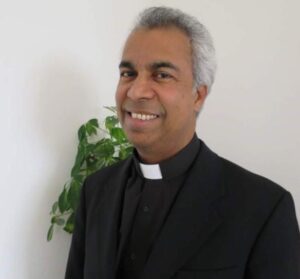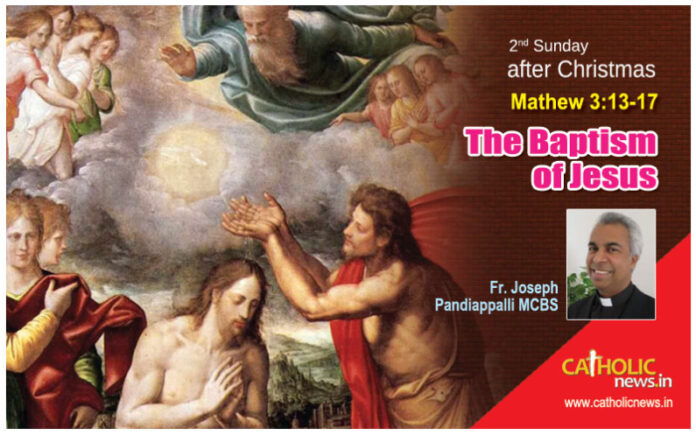8th January 2023

Two weeks back we celebrated Christmas. After that we celebrated the new year, the fest of the Mother of God and the feast of Epiphany. After the exile to Egypt Joseph and Mary returned to their hometown Nazareth as they heard about the death of Herodes, as Jesus was twelve years old the holy family made a pilgrimage to Jerusalem, afterwards Joseph died, Jesus grew up as a Jung man and became thirty years old. Jesus received the baptism before starting his public ministry from John the Baptist.
Today we celebrate the baptism of the Lord. With this feast the liturgical end of the Christmas season is declared. Tomorrow onwards the readings of the liturgy will remind us of the public ministry of Jesus.
Just as Jesus was baptised through John the Baptist we were all once baptised. Today on the feast of the baptism of Jesus, we pray for the coming of the Holy Spirit and hope to hear as it was said about Jesus: You are my beloved Son/Daughter, I am pleased in you.
With the baptism of Jesus in the river of Jordan through John the Baptist the rite of baptism got a new dimension. People were baptised before the coming of Christ in the pre-christian period in different cultures and religions and after the baptism of Christ elsewhere than in Christianity. It was celebrated in different selected rivers of the world. Where there was no river, people were baptised in a lake or near a well or even with a cup of water. Sometimes a ritual washing substituted the baptism. All these were for the forgiveness of sin. Nile in Egypt, Jordan in Israel and Ganges in India were the most important rivers of the world where people were baptised for the forgiveness of sin. It was the wish of many Indians who lived far away from Ganges to go to Ganges once in lifetime and get baptised in the water of Ganges for the forgiveness of sin.
The activity of John the Baptist in Jordan was quite normal and usual at the first sight for many those who lived in Egypt, Babylon, Israel or India. Even today many Hindus could understand such a baptism with water in the river of Jordan. In spite of that the baptism of John the baptist was different from the baptism of different cultures and religions where people freely decided to get baptised in a particular river and prayed God for the forgiveness of sin.
John the Baptist invited the people for the baptism; he warned the people, demanded them to confess their sins, and called them to get baptised. Usually people went to the water and baptised themselves, but John the Baptist baptised the people. The role of a second person as the one who baptised in the rite of baptism was the introduction of John the Baptist. Through the invitation and warning, John the Baptist motivated and proselytised the people. His sermon created fear and terror. Since John the Baptist was convinced of his mission and the need of the people and the society to get converted, he was not shy to warn the people. His duty was to prepare the people to receive Jesus and his message.
John the Baptist considered himself unworthy to carry even the sandals of Jesus. He prepared the way for Jesus. Besides, Jesus himself came to John the Baptist and requested him to baptise him. But John the Batist liked to have baptised through Jesus. Nobody at the bank of Jordan knew Jesus at that time. John the Baptist knew his relative Jesus and about the mission of Jesus. Jesus decided to stand with the sinners and get baptised through John. This simplicity and humility to identify himself with the week, the poor and the sinners is a reminder to think about our attitude towards other people, especially towards the poor and the oppressed. After receiving the baptism Jesus began to preach the good news to the poor.
During the baptism of Jesus a voice heard from heaven: this is my son whom I love; with him I am pleased. A similar voice was heard on mount Tabor during the transformation of Jesus: this is my beloved son. During the crucifixion the captain said about Jesus: he is really Son of God. In the Prologe of St. John we read that those who receive Jesus and believe in ihn have got the right to become the children of God. That means, all those who are baptised have the right to be the children of God. As baptised Christians we could be very happy to be the children of God.
Perhaps many of us do not remember about our own baptism because many of us were baptised as small babies or small children. But many of us have taken part in a baptism ceremony. Some times baptism is celebrated in a Sunday liturgy or every year in the easter vigil. For the candidate baptism means profession of Christian faith and belongingness to the Christian church. With the baptism a child begins to learn the values, the principles and the duties of a Christian. With confirmation it begins to live and act as a full Christian with all the rights and duties of a Christian. Out of this reason baptism and confirmation are given together in adult baptism. From the second century onwards children were baptised and the parents took responsibility for the Christian formation of their baptised children. Naturally the godfathers are also responsible for the formation of the newly baptised children. Therefore the period of catecumenate is not excepted for children where as the adult should undergo this period before receiving catechism, which was a period of three years in the early church. Confirmation was conferred at a stage a child is able to confess its faith on its own. Today majority of the patents follow the tradition of the child baptism. But there is possibility of adult baptism also in the catholic church.
Baptism is the initiation ceremony. Through baptism one is initiated to the christian faith, into the community of the faithful, to the teachings of the church on Christ, and to the experience of God. Baptism ceremony as initiation ceremony is anchored in the words of Jesus: „Go therefore and make disciples of all nations, baptizing them in the name of the Father and of the Son and of the Holy Spirit, teaching them to observe all that I have commanded you; and lo, I am with you always, to the close of the age.”(Mt 28:19-20).
But the baptism of Jesus was not an initiation ceremony. It was the baptism for the sinners which was common in Judaism, Hinduism and in many other cultures and religions at that time and even today. Baptism with water requires the readiness to repent, get converted and to believe. Since Jesus was not a sinner, but a holy Man, as holy as God, John the baptist did not will to baptise him. But by receiving the baptism of the sinners Jesus expressed his solidarity with the people of Palestine and of the whole world. God equals himself with the sinful humanity. The Holiness of Jesus is through the descending of the Holy Spirit in the form of a dove is confirmed.
From 6th century before Christ (B.C.) onwards dove was the symbol of holiness and bliss in Syria and Palestine. From 3rd century onwards dove was the symbol of goddess in Babylon, Assyria, Greece and Rome, especially of the goddess of love. In the Bible dove is the symbol of peace. The coming of the Holy Spirit in the form of dove expresses the message that Jesus is holy and blissful, he is bringing peace and is God-like or God himself. The voice from the heaven: His is my beloved Son in whom I am pleased, verify and confirm the divinity, holiness and bliss of Jesus. This becoming equal of Jesus with the human is an invitation to every one to become equal with the Holy God Himself.
The sinful human receives the sacrament of baptism. Baptism is given in the name of Jesus, of the Father and the Holy Spirit. Through that the sinful human is taken up into the community of the saints. Communio sanctorum, community of the saints, is the church. Therefore Christian baptism is entirely different from the baptism of Jesus; but through the Christian baptism one is invited to become equal and similar to Jesus.
During the ceremony of baptism the newly baptised receives a burning candle. It shows that he receives Jesus as light of the world and confesses that the baptised person wanted to move unter this light who is Christ. The anointing with crisam means that the newly baptised person is the chosen one of God. The word Christ means the anointed one. Jesus himself is the anointed one, the chosen one, the Son of God. Every baptised person is raised to the same status. Anointing has also the symbol of the transmission of power. In Egypt the Pharao anointed his ministers as sign of transmission of his power. Through baptism and anointing , the baptised person becomes the child of God whom the power of God is transmitted. Besides, in the Old Testament priests, prophets and kings were anointed. Jesus is king, Prophet and priest. Through anointing every baptised person participate in these three duties of Jesus.
Our role model is Jesus the Christ who got baptised through John the Baptist. The receiving of the Holy Spirit and entry in to community of the faithful are the special features of the Christian baptism.
On the feast of the baptism of Jesus we can deepen our belongingness to the church.
On the feast of the baptism of Jesus we are invited to become aware that we could become similar to Jesus Christ through our words and deeds. We are invited to reflect whether we as „communio sanctorum“, as community of the saints bring to our community the fruits of it in the forms of faith, love, hope, feeling of security and peace. Let us work together and make the first step.
Fr. Joseph Pandiappalli MCBS



